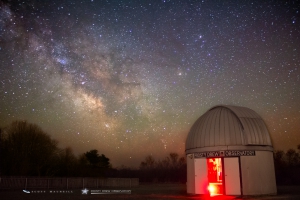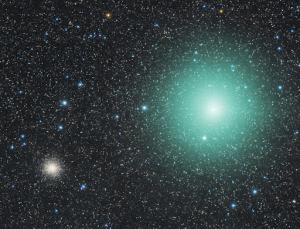
Stargazing Night
- Where:
- Frosty Drew Observatory
- When:
- Friday April 8, 2016 at 8:00 p.m.
- Cost:
- $1 Suggested Donation per Person
Tonight is Stargazing Night at Frosty Drew Observatory and the forecast is looking potentially great! We can expect a quick bout of partly cloudy skies just after we open, becoming mostly clear as twilight moves out. Winds will be borderline high at start but will calm overnight. At sunset, the ridiculously thin 4% waxing crescent Moon will offer up mystical views as it hangs low in the western sky, setting at 8:54 offering up a stunningly dark starscape to revel in all night. These conditions can make for a fabulous night out under the stars.
We will open the Observatory and Sky Theatre at 8:00 p.m. In the Observatory, telescopes will showcase the sexy crescent Moon to start, followed by fabulous views of Jupiter and the four Galilean Moons with the Great Red Spot on display and a shadow transit, compliments of Europa which will be casting its shadow on Jupiter's atmosphere. As the night progresses, the Orion Nebula, dozens of galaxies, and star clusters will be on display. After midnight, we will try for our first views of Saturn for the 2016 season. In the Sky Theatre we will feature warm temps and a showcase of celestial objects photographed at Frosty Drew, a nice place to catch a break from the cooler outside temps. We will stay open until at least midnight and will post a “Closing up” message to our Twitter (@FrostyDrewOBSY) and Facebook when we decide to pack it in.
Overall, tonight has a very high probability of being our first really awesome night of the Milky Way viewing season. Awesome views of the Moon early, followed by moonless skies will give us many opportunities to check out dim celestial objects not visible under light polluted or moonlit skies. If clouds can stay out, we will certainly rock the starscape. So grab a warm jacket, maybe a camera, telescope, or just your geeky self and set out for a fabulous night under the darkest skies in Rhode Island and discover that inner astro-geek that's waiting to break free!
-------------------------------------------------------------------------
Weekly Happenings
Scott MacNeill
Now that the International Space Station (ISS) is back in the Northeast U.S. evening skies, visible passes abound. Catch the ISS passing over New England at 9:10 tonight. The Station will first appear on the North Northwest horizon and rise to about 16° heading towards the North Northeast. It will appear like a bright moving star or an airplane that doesn't blink. The pass will last 3 minutes, at which point the ISS passes into Earth's shadow. If you miss out tonight, you can catch it again tomorrow night at 8:17 in almost the same place. If you visit Frosty Drew tonight, you can see it with us as we will be pointing it out.
Did you hear about the pair of comets that passed super close to Earth a few weeks ago? Well that was Comet 252P/LINEAR and Comet P/2016 BA14. Both objects passed remarkably close to Earth putting them in the top five closest comets in recorded history. Though the pass has completed, the awesome is just kicking in.
Comet 252P/LINEAR was discovered in April 2000 and is a periodic comet that orbits the Sun once every 5.3 years. The comet has a rather small orbit around the Sun, compared to Ort Cloud comets, with its furthest point (aphelion) being generally about 5 AU (5 times the distance of the Earth from the Sun).
Comet P/2016 BA14, discovered in January 2016 and initially thought to be a Near Earth Asteroid (NEA), is very likely a fragment of Comet 252/P. Measuring at nearly half the size of Comet 252/P and following a remarkably similar orbit, BA14 is quite a large fragment comparatively.
On March 21, 2016 Comet 252P/ LINEAR passed Earth at a distance of 3.3 million miles, making it the fifth closest comet to pass Earth in recorded history. The following day, March 22, 2016, Comet P/2016 BA14 passed Earth at a distance of about 2.2 million miles, making it the third closest comet to pass Earth in recorded history and the closest in 246 years.
This, of course, all happened for Southern Hemisphere comet watching geeks. Though not any more, as Comet 252P/LINEAR is now quite visible in the Northern Hemisphere skies. The best part of all this is that Comet 252P was initially thought to remain quite dim and rather unimpressive visually, but that is not what happened. An unexpected outburst occurred in mid March, increasing the comets visibility by 100 times what was expected! The comet's coma (the thin atmosphere that forms around the comet's nucleus due to out-gassing) has grown incredibly to a diameter of 55,923 miles. That is half the size of Jupiter! This massive increase in brightness coupled with its huge coma, places Comet 252P/LINEAR at or very near the naked eye viewing limit.
Viewing the comet will be easy now that the Moon is out of the question. Set out after 1:00 a.m., packing binoculars, to a dark location. Look towards the constellation Ophiuchus, which will be in the Southeast and heading South as morning moves in. The comet may be visible to the unaided eye if under very dark, clear skies. It will be easily visible in binoculars as a large glowing object. If you're into photographing the Milky Way, then you are totally set up! Ophiuchus is just above the galactic plane making it an excellent chance to photograph the comet along the Milky Way. If you happen to catch a shot of the comet, be sure to post it on our Facebook and we will share it on our time line. Happy springtime comet hunting!
-Scott


